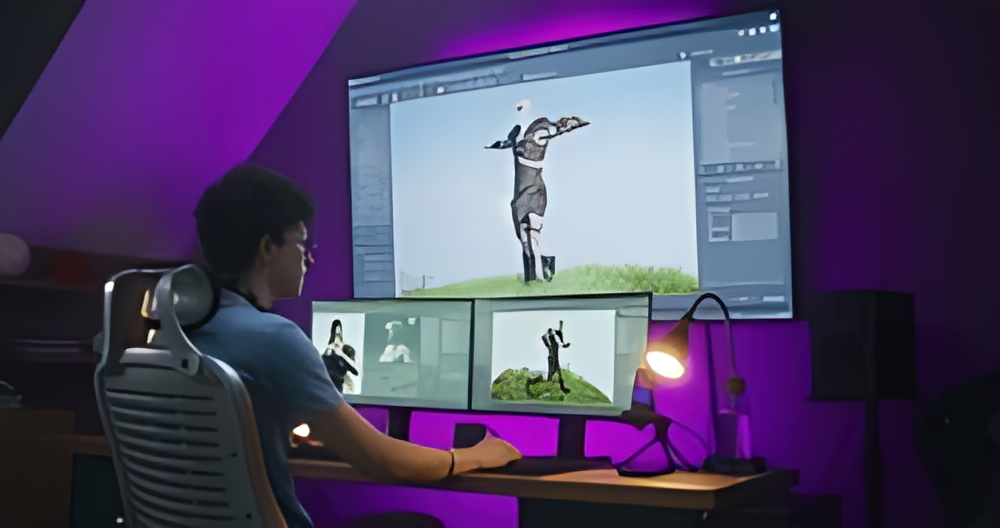Unity is a monolith in the game development community. It is a tremendously helpful game engine that enables you to streamline the game development process.
With a comprehensive built-in tool kit, Unity provides a user-friendly interface, a collaborative ecosystem, and a democratized game creation process that makes it inviting to newcomers.
Unity has a nearly 48% market share and a market capitalization of nearly $9.158 billion as of April 17, 2024. As the dominant game engine in the industry, it is naturally the leading choice of professional game devs and any game development studio.
Unity in Game Development has led to the creation of popular games such as Angry Birds 2, Pokemon Go, Genshin Impact, Among Us, etc.
Let us now take a look at what makes Unity so successful as a game mechanics engine.
1. Cross-Platform Support
Unity enables you to develop games that run across a vast array of devices without compromising the performance. These can be PCs, smartphones, consoles, and even VR headsets.
This is cross-platform functionality.
With this feature, game developers can reach a wider audience of players. This is almost necessary because players expect to access their games on their preferred devices.
How does Unity do this?
Unity employs a single-codebase approach. Developers need to write their game logic once and they will be able to run it across multiple platforms. This saves them time and resources, while still delivering consistent gameplay experiences.
There are several tools designed to facilitate cross-platform development. These range from platform-specific optimizations to built-in testing and debugging features. These help in addressing the unique requirements of each platform.
2. Asset Store and Community
The Unity Asset Store and community are a cornerstone of its ecosystem. They offer resources, tools, and assets.
These include things like ready-made character models and environmental assets to specialized scripts and plugins. They accelerate the development process.
This also fosters a sense of community among developers. They can share their creations, learn from one another, and collaborate on projects.
The community’s support extends beyond the digital realm. Events like Unite conferences and local meetups bring developers together to network, learn, and celebrate their shared passion for game development.
3. Integration with Popular Tools
Developers can easily leverage their preferred tools and streamline their development pipelines. This is due to Unity’s compatibility with industry-standard software.
For artists and designers, Unity offers native integration with digital content creation (DCC) tools such as Autodesk Maya, Blender, and Adobe Photoshop. This allows for the direct import of assets, textures, and animations into Unity, preserving fidelity and reducing the need for manual conversion or optimization.
Unity’s integration with audio editing software like FMOD Studio and Wwise allows developers to create immersive soundscapes with ease.
Unity’s compatibility with version control systems such as Git and Perforce simplifies collaboration and project management. This translates to efficient team work.
Finally, Unity’s support for popular programming languages like C# and JavaScript allows developers to integrate third-party libraries and frameworks, thereby expanding the platform’s capabilities.
4. Accessibility and Democratization
Game development was hard to get into unless you had extensive programming knowledge and access to expensive tools. But Unity has changed all that.
With its intuitive interface and comprehensive documentation, Unity empowers individuals with all levels of experience to create games on it.
It has features like the drag-and-drop functionality, visual scripting tools like Bolt, and extensive library of tutorials. With this, aspiring developers can learn and iterate faster.
As a Unity 3D game development company, EDIIIE has employed this game engine for game and game asset creation across several projects.
5. Visual and Audio Capabilities
Audiovisual assets give shape to the game and the gaming experience.
With Unity, you can use real-time rendering technologies like HDRP (High Definition Render Pipeline) and URP (Universal Render Pipeline). They help you create the visuals you desire for your game environment.
With Unity, developers can leverage tools like audio mixer, spatial audio, and dynamic sound effects to create soundtracks that enhance the immersion and narrative.
6. AI Integration
Artificial Intelligence (AI) allows devs to create more responsive gaming environments. AI-powered NPCs (non-player characters) can evolve with player actions. From intelligent enemy AI that learns and adapts to player strategies to companion characters with believable personalities and emotions.
Procedural content generation can automate the creation of game levels, environments, and assets. This reduces the burden on developers and allows them to create larger and more diverse game worlds.
AI-powered analytics tools can also provide valuable insights into player behavior and preferences, helping developers optimize game mechanics, balance difficulty levels, and tailor experiences to individual players.
Conclusion
Unity is the leading physics engine in game development today. And thanks to its democratized functionality, it is available for use for all.
So, whether you’re a newcomer or a pro, there is no better time to jump in than right now.
Get started right away and make your ideas a reality!
Also read: The Growth of the Gaming Industry



